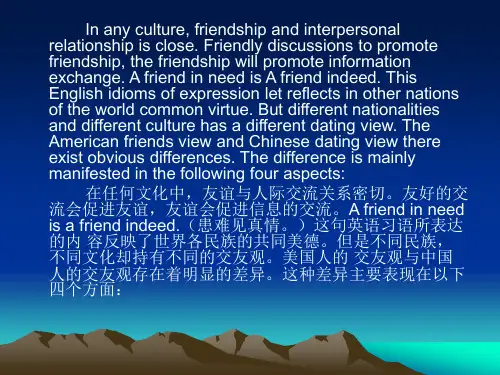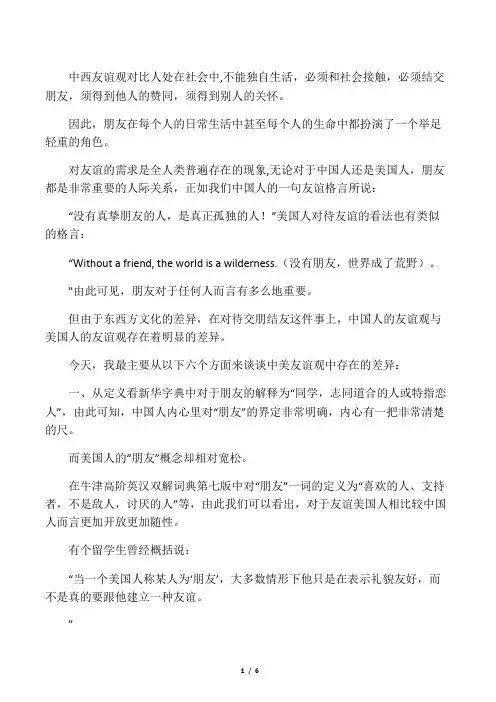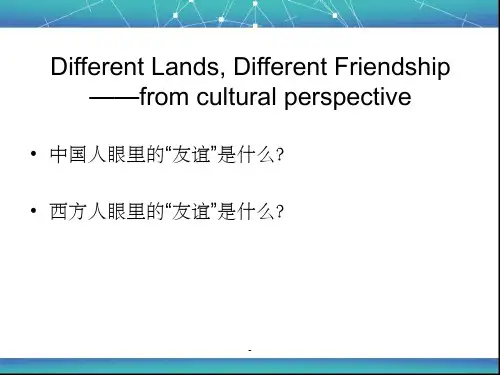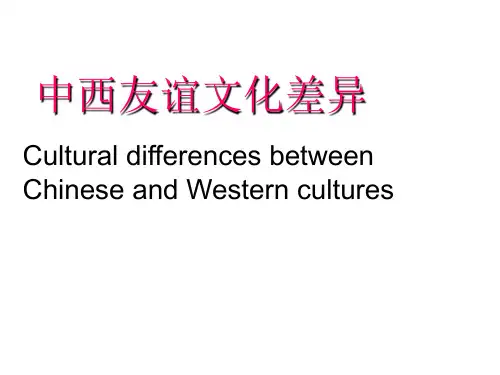中西友谊观对比共39页文档
- 格式:ppt
- 大小:4.04 MB
- 文档页数:39

科技信息中西方文化中都很重视友谊。
相应地,在一些名言或谚语中,对友谊都有所表达。
尽管汉语中的“朋友”、“友谊”对应英语中的“friend”、“friendship”,但是在中国文化和美国文化中,朋友、友谊的内涵和对朋友、友谊的理解大不相同。
在中国文化中,朋友指志同道合的人,后来泛指交谊深厚的人,友谊是朋友间深厚的感情、亲密的关系。
而美国的friend,是指有共同感受或喜好、能在一起愉快地交流的人,可以用来指非常广泛的人际关系,friendship 在很大程度上是一种伙伴关系。
由于社会文化背景、思维方式等方面的差异,中西方对朋友和友谊的认识和表达方式有很多差别。
如果在跨文化交际中不重视或无视这种差异,将二者等同理解,就有可能带来交际的困难,造成交际双方的误解。
因此本文将从三个方面对比分析中西方朋友和友谊的内涵差异。
一、范围不同金庸曾谈到中国人把好朋友视作兄弟,通过义结金兰这种方式和异姓朋友结拜为兄弟,并立誓:“虽非同年同月同日生,但愿同年同月同日死。
”金庸说:“西方社会中,只有热烈相爱的恋人,才会立誓同死。
但在中国这个重义气的社会,友情比爱情更受重视。
”这也说明在中国文化里,“朋友”是指可以互相信任,互相倾诉,感情很深的关系。
与中方来比,西方中朋友概念的范围更广泛。
对西方人来说,“朋友”可以用来指童年的玩伴、在新地方刚认识几天的人、关系密切的商务伙伴、一个深受信赖的知己等。
友谊可以是肤浅的、暂时的也可以是深厚的、长久的。
这也由于美国人一贯开放自由的态度,能够轻松、随时随地交上朋友。
雷尼尔(AlisonLanier)在其撰写的《生活在美国》(Liv-ingintheUSA,1981)一书中指出:美国是一个流动性很强的国家。
美国人很容易结交到朋友,但是,一旦环境改变,友情也会变化。
另外,在中国,朋友贯通各个方面,朋友之间无所不谈,生活上、工作上都互相帮助。
而在美国,朋友只局限于一个领域,不会延伸至其他领域。

《吉林广播电视大学学报》2006年第0期中美友谊概念的对比研究陆欣王小芳(长春大学,吉林长春130000;吉林大学,吉林长春130000)摘要:中国和美国由于文化背景的差异造成对友谊概念的理解也有所同。
本文从范围和层次不同、深浅和牢固程度不同、交谈话题不同和责任理解不同四个方面进行对比。
对中美友谊概念差异的深入了解有助于发展和巩固跨文化友谊。
关键词:友谊;范围;层次;深浅;牢固程度;价值观;责任中图分类号:G04文献标识码:A文章编号:1008-7508(2006)04-0076-04在任何文化中,友谊与人际交流关系密切。
友好的交流会促进友谊,友谊会促进信息的交流。
A friend in need is a friend indeed.(患难见真情。
)这句英语习语所表达的内容反映了世界各民族的共同美德。
但是不同民族,不同文化却持有不同的交友观。
美国人的交友观与中国人的交友观存在着明显的差异。
这种差异主要表现在以下四个方面:一、范围和层次的不同中国人的所结成的友谊关系一般有两种:一种是“熟人”,即由工作关系、邻居关系认识的人。
第二种是朋友,这和英语中的friend含义有差别,中国人所称的朋友一般是志同道合、互相关心、互相帮助并可在感情上依托的人,这是一种亲密的、有深交的人际关系,可以自由自在的谈论彼此心中深层次的思想。
“朋友”在汉语中有两个意思:一是彼此有交情的人;一个是指“恋爱的对象”(《现代汉语词典》)。
中国人一般熟人多,但朋友不多。
前一种意义上的朋友一般是同性,异性朋友很少,因为这常有谈恋爱或婚外恋的嫌疑。
美国人的友谊关系是建立在共同的理想和价值观、真诚和信任、社会和心理的支持的基础上的。
美国人一般把友谊关系分为泛泛之交、好友、密友和深交。
美国人往往有许许多多的泛泛之交、好友、密友,且男性和女性兼有。
深交友谊关系也包括男女两性,但是数量较少,以志趣相投为基础。
在许多国家,朋友必须是同性的,然而,大部分美国人认为可能存在异性朋友,他们通常也不认为男女单独相处就会发生性行为。

收稿日期:2008-01-09作者简介:黄滢(1981—),女,江苏南通人,南通航运职业技术学院人文艺术系助教。
摘要:文章基于人际关系的基本理论出发,从四个方面分析了中美友谊观的差异性,揭示了中美价值观中的横沟并探寻了各自价值观的根源。
关键词:友谊;差异;价值观;跨文化交流;人际关系中图分类号:C912.1文献标识码:A文章编号:1671-9891(2008)03-0031-03中美友谊观之对比分析黄滢(南通航运职业技术学院人文艺术系,江苏南通226010)第7卷第3期2008年9月南通航运职业技术学院学报JOURNALOFNANTONGVOCATIONAL&TECHNICALSHIPPINGCOLLEGEVol.7No.3Sep.20080引言现今,越来越多的中国学生、访问学者、移民者去美国进一步地学习深造、讲学或工作。
在这种背景下,我们不可避免地要与美国人交朋友,了解其文化。
因此了解中美友谊观的差异性及与美国人的交友原则可以使得自身很快融入当地文化、提高学习工作效率。
1人际关系的三种不同类型人际关系是跨文化交际中一个基本部分而友谊在人际关系中扮演一个重要角色,因此谈到中美友谊观的差异性首先要提及人际关系理论。
人际关系指社会人群中因交往而构成的相互依存和相互联系的社会关系,属于社会学的范畴,包括朋友关系、同学关系、师生关系、雇佣关系等。
总的来说,人际关系可以分为三类:①工具型②情感型③复合型。
[1]“工具型”即人们利用某种人际关系达到自己的目标或获取某种利益。
“情感型”即人们互相依赖尽量满足对方的需要。
“复合型”则包含情感型和工具型,这种关系指人们往往互相了解,和谐相处达到一定的程度,但这种关系也不是最为真挚的,还是有一定目的的。
一般认为,中国人的相处类型应属于情感型和复合型,而美国人的相处类型应偏向于工具型。
因此在相处中,中国人会觉得美国人太实际太自我,没有人情味。
而美国人会觉得中国人太过依赖别人,要求太多,什么都要讲关系。


中西友谊观对比人处在社会中,不能独自生活,必须和社会接触,必须结交朋友,须得到他人的赞同,须得到别人的关怀。
因此,朋友在每个人的日常生活中甚至每个人的生命中都扮演了一个举足轻重的角色。
对友谊的需求是全人类普遍存在的现象,无论对于中国人还是美国人,朋友都是非常重要的人际关系,正如我们中国人的一句友谊格言所说:“没有真挚朋友的人,是真正孤独的人!”美国人对待友谊的看法也有类似的格言:“Without a friend, the world is a wilderness.(没有朋友,世界成了荒野)。
”由此可见,朋友对于任何人而言有多么地重要。
但由于东西方文化的差异,在对待交朋结友这件事上,中国人的友谊观与美国人的友谊观存在着明显的差异。
今天,我最主要从以下六个方面来谈谈中美友谊观中存在的差异:一、从定义看新华字典中对于朋友的解释为“同学,志同道合的人或特指恋人”,由此可知,中国人内心里对“朋友”的界定非常明确,内心有一把非常清楚的尺。
而美国人的“朋友”概念却相对宽松。
在牛津高阶英汉双解词典第七版中对“朋友”一词的定义为“喜欢的人、支持者,不是敌人,讨厌的人”等,由此我们可以看出,对于友谊美国人相比较中国人而言更加开放更加随性。
有个留学生曾经概括说:“当一个美国人称某人为‘朋友’,大多数情形下他只是在表示礼貌友好,而不是真的要跟他建立一种友谊。
”二、“友谊”持续时间在中国,友谊往往是坚固、稳定甚至是终身的。
就算是分别两地,朋友之间往往都会相互联系,或许是通过打电话或是聚会等,两者的友谊并不会随着时间的流逝而消逝。
外国人对友谊并不一定追求“永恒”,美式友谊就有些“速溶咖啡”的味道了,朋友交得快,忘得也快。
美国是全世界流动性最大的一个国家,这种流动性使得美国人的人际关系相对淡薄。
美国人对朋友的热情很快能从一个人转移到另一个人。
因此,在美国,朋友之间如果一段时间内不联系、不见面,他们的友谊就会迅速地枯萎甚至死亡。


xxxx观对比人处在社会中,不能独自生活,必须和社会接触,必须结交朋友,须得到他人的赞同,须得到别人的关怀。
因此,朋友在每个人的日常生活中甚至每个人的生命中都扮演了一个举足轻重的角色。
对友谊的需求是全人类普遍存在的现象,无论对于中国人还是美国人,朋友都是非常重要的人际关系,正如我们中国人的一句友谊格言所说:“没有真挚朋友的人,是真正孤独的人!”美国人对待友谊的看法也有类似的格言:“Without a friend, the world is a wilderness.(没有朋友,世界成了荒野)。
”由此可见,朋友对于任何人而言有多么地重要。
但由于东西方文化的差异,在对待交朋结友这件事上,中国人的友谊观与美国人的友谊观存在着明显的差异。
今天,我最主要从以下六个方面来谈谈中美友谊观中存在的差异:一、从定义看新华字典中对于朋友的解释为“同学,志同道合的人或特指恋人”,由此可知,中国人内心里对“朋友”的界定非常明确,内心有一把非常清楚的尺。
而美国人的“朋友”概念却相对宽松。
在牛津高阶英汉双解词典第七版中对“朋友”一词的定义为“喜欢的人、支持者,不是敌人,讨厌的人”等,由此我们可以看出,对于友谊美国人相比较中国人而言更加开放更加随性。
有个留学生曾经概括说:“当一个美国人称某人为‘朋友',大多数情形下他只是在表示礼貌友好,而不是真的要跟他建立一种友谊。
”二、“xx”持续时间在中国,友谊往往是坚固、稳定甚至是终身的。
就算是分别两地,朋友之间往往都会相互联系,或许是通过打电话或是聚会等,两者的友谊并不会随着时间的流逝而消逝。
1 / 5外国人对友谊并不一定追求“永恒”,美式友谊就有些“速溶咖啡”的味道了,朋友交得快,忘得也快。
美国是全世界流动性最大的一个国家,这种流动性使得美国人的人际关系相对淡薄。
美国人对朋友的热情很快能从一个人转移到另一个人。
因此,在美国,朋友之间如果一段时间内不联系、不见面,他们的友谊就会迅速地枯萎甚至死亡。


《吉林广播电视大学学报》2006年第0期中美友谊概念的对比研究陆欣王小芳(长春大学,吉林长春130000;吉林大学,吉林长春130000)摘要:中国和美国由于文化背景的差异造成对友谊概念的理解也有所同。
本文从范围和层次不同、深浅和牢固程度不同、交谈话题不同和责任理解不同四个方面进行对比。
对中美友谊概念差异的深入了解有助于发展和巩固跨文化友谊。
关键词:友谊;范围;层次;深浅;牢固程度;价值观;责任中图分类号:G04文献标识码:A文章编号:1008-7508(2006)04-0076-04在任何文化中,友谊与人际交流关系密切。
友好的交流会促进友谊,友谊会促进信息的交流。
A friend in need is a friend indeed.(患难见真情。
)这句英语习语所表达的内容反映了世界各民族的共同美德。
但是不同民族,不同文化却持有不同的交友观。
美国人的交友观与中国人的交友观存在着明显的差异。
这种差异主要表现在以下四个方面:一、范围和层次的不同中国人的所结成的友谊关系一般有两种:一种是“熟人”,即由工作关系、邻居关系认识的人。
第二种是朋友,这和英语中的friend含义有差别,中国人所称的朋友一般是志同道合、互相关心、互相帮助并可在感情上依托的人,这是一种亲密的、有深交的人际关系,可以自由自在的谈论彼此心中深层次的思想。
“朋友”在汉语中有两个意思:一是彼此有交情的人;一个是指“恋爱的对象”(《现代汉语词典》)。
中国人一般熟人多,但朋友不多。
前一种意义上的朋友一般是同性,异性朋友很少,因为这常有谈恋爱或婚外恋的嫌疑。
美国人的友谊关系是建立在共同的理想和价值观、真诚和信任、社会和心理的支持的基础上的。
美国人一般把友谊关系分为泛泛之交、好友、密友和深交。
美国人往往有许许多多的泛泛之交、好友、密友,且男性和女性兼有。
深交友谊关系也包括男女两性,但是数量较少,以志趣相投为基础。
在许多国家,朋友必须是同性的,然而,大部分美国人认为可能存在异性朋友,他们通常也不认为男女单独相处就会发生性行为。


从影视剧看中西方文化友谊观的差异在众多的文化因素中,价值观是核心内容之一,具有持久性、稳定性,是人们对社会存在的反映,是为社会成员所普遍接受的信念。
中国与西方国家在历史、地理、风俗习惯、宗教信仰、科技与经济发展等诸多方面均有很大差异,因此,了解中西方友情观的差异就变得非常迫切和重要了。
《武林外传》和《老友记》分别是中美影视剧中最受欢迎的情景喜剧。
两者都讲述了几个来自不同地方、不同成长背景且性格迥异的年轻人机缘巧合下住到一起后发生的一系列故事。
影视剧用幽默的语言和夸张的表演展现了两拨年轻人因为情感、原则、生活发生矛盾、闹出笑话到最后和谐解决的一个个生活趣事。
作为观众的我们在被逗笑或被感动的同时,也看到了两国年轻人对待生活的态度,有相同之处也存在差异。
比如我们今天要讲的友谊观。
相同的是中美文化中都非常重视友谊,但是不能否认的是不同文化背景下的中美友谊观存在或多或少的差异。
其中最主要的就是朋友间的独立性。
一、以经济状况为主线的剧情回顾及对比在《武林外传》中,几乎每顿饭大家都是聚在一起吃的,李大嘴负责做饭,没有人去计算每个人应该承担多少饭钱,每个人都觉得这是一种很自然的现象。
谈钱伤感情是中国人常说的话,剧中的吕秀才为了讨要郭芙蓉欠他的二钱银子,委婉地提到“二泉映月”“二清关”等各种提示词汇,最后还是不敢直说是要钱。
在《老友记》中,有不少六个人一起聚餐的场景。
我们不难发现,尽管六个人经济状况不同,但是每次聚餐买单他们都是AA制。
六个人中Phonbe、Rachel经济条件较差,但在昂贵的餐厅他们宁愿什么菜都不点也不会产生让朋友买单蹭吃蹭喝的心理,同时几个经济状况较宽裕的出于尊重除非是他们设宴邀请否则也不会付掉应该别人承担的费用。
二、基于剧情的中美友谊观的差异分析――个人独立及隐私性在以上两个情节中我们可以发现,中美友谊观差异中其中一个最明显也是最主要的就是朋友间的独立性及隐私性的差异。
中国朋友之间的亲密程度是比较高的,不论是人情上还是金钱上,都存在具体的帮助和来往,朋友间有着很强的相互依赖的合作关系。
中西方对友谊的不同看法英语作文英文回答:Friendship, a fundamental aspect of human interaction, holds significant cultural implications, influenced by societal norms, values, and beliefs. While Western and Eastern perspectives share commonalities, they also exhibit notable differences in how they conceptualize and experience friendship.Emphasis on Individualism vs. Collectivism.Western societies emphasize individualism, prioritizing personal autonomy and self-reliance. Friendships are typically formed based on shared interests, values, and experiences. Individuals are expected to maintain their own identities within the friendship and seek personal fulfillment through their relationships.In contrast, Eastern cultures, particularly in EastAsia, adhere to a collectivist worldview. Friendships are often rooted in shared social groups, such as family, school, or workplace. Individuals prioritize group harmony and loyalty over personal desires. They are expected to conform to societal expectations and place the needs of the group above their own.Purpose of Friendship.In the West, friendships serve predominantly as a source of emotional support, companionship, and personal growth. Friends are often confidants, providing a safe space to share intimate thoughts and experiences. Relationships are valued for their ability to enhance one's sense of well-being and purpose.In Eastern cultures, friendships also play a practical role. Friends serve as a network of support, providing assistance in various aspects of life, including financial, professional, and family matters. Loyalty and reciprocity are highly valued in these relationships.Communication Styles.Communication in Western friendships tends to be direct and explicit. Individuals are encouraged to express their thoughts and feelings openly, even if it may cause discomfort. Friendships are often characterized by verbal banter, humor, and self-disclosure.In Eastern cultures, communication is often indirect and implicit. Individuals may avoid direct confrontation to maintain harmony. They favor nonverbal cues, such as facial expressions, body language, and situational context, to convey their intentions.Time and Distance.In Western societies, friendships are often maintained over long distances and extended periods. Individuals may move away for education, work, or family reasons, but they continue to prioritize their friendships through frequent communication and occasional visits.In Eastern cultures, physical proximity and shared experiences are crucial for maintaining friendships. Due to the emphasis on collectivism, friendships are often tied to specific social groups. As individuals move or leave those groups, the intensity of their friendships may diminish.Conclusion.While both Western and Eastern perspectives on friendship acknowledge the importance of intimacy, support, and shared experiences, they differ in their emphasis on individualism, purpose, communication styles, and the role of time and distance. These differences reflect the unique cultural values and norms that shape how individuals form and maintain friendships in different societies.中文回答:对友谊的看法差异。
中西方对待友谊的差异英语作文**Differences in the Concept of Friendship betweenChina and the West**Friendship, a bond that exists across cultures and throughout history, often manifests itself differently depending on the social and cultural context. In this essay, we will delve into the distinct perspectives on friendshipin China and the West, examining the underlying values and expectations that shape these relationships.In the West, friendship is often characterized by a strong emphasis on individuality and autonomy. Western friends value honesty and directness, often communicating their thoughts and feelings freely without fear ofoffending each other. Independence is a cornerstone of Western friendships, as individuals are expected tomaintain their own interests and identities outside of the friendship dynamic. This autonomy extends to the giving and receiving of help; while Western friends are willing to assist each other, they also expect their friends to beself-reliant and not过分依赖.On the other hand, the Chinese perspective onfriendship is shaped by a stronger emphasis on collectivism and harmony. Chinese culture values relationships that are built on trust, respect, and mutual obligation. Friends are expected to support and understand each other, even when it comes to matters of conflict or disagreement. In Chinese friendships, directness and honesty are valued, but they are tempered by the need to maintain harmony and avoid conflict. This is reflected in the way Chinese friends interact, often communicating indirectly and using euphemisms to avoid direct confrontation.Another significant difference lies in the concept of personal space and privacy. Western friends tend to value a certain degree of privacy and personal space, expecting their friends to respect their boundaries. In contrast, Chinese culture often views friends as extensions of oneself, with less emphasis on maintaining strict boundaries. This can lead to a greater degree of intimacy and closeness in Chinese friendships, with friends often sharing more personal details and experiences than their Western counterparts.Finally, the role of time and longevity in friendships differs between China and the West. Western friendships often develop over time through shared experiences and mutual interests, with the quality of the relationship being more important than the duration. In contrast, Chinese culture values long-standing friendships, with the passage of time often strengthening the bond between friends. This is reflected in the Chinese saying "old friends are gold," which emphasizes the value of maintaining friendships over the course of one's life.In conclusion, the concept of friendship exhibits significant differences between China and the West. Western friendships are characterized by individuality, autonomy, and privacy, while Chinese friendships are built on trust, mutual obligation, and the value of long-standing relationships. These differences can be attributed to the underlying values and cultural norms that shape friendships in each context. Understanding these differences can help us better appreciate the richness and diversity of friendship across cultures.**中西友谊观的差异**友谊,这一跨越文化和历史长河的纽带,在不同的社会和文化背景下常常展现出不同的形态。
比较中西方友谊的三个方面英语作文When comparing the aspects of friendship between the East and the West, there are several key differences and similarities to consider. Let's take a look at three important aspects: communication, loyalty, and social activities.Firstly, in terms of communication, there is a noticeable difference between the East and the West. In Western cultures, friends tend to communicate more openly and directly. They are comfortable expressing theirfeelings and opinions, even when they are in disagreement. On the other hand, in Eastern cultures, there is often an emphasis on maintaining harmony and avoiding confrontation. As a result, friends may communicate in a more indirect and subtle manner, especially when dealing with sensitive topics.Secondly, loyalty is another important aspect of friendship that differs between the East and the West. In Western cultures, loyalty is often demonstrated through honesty, reliability, and standing by a friend throughthick and thin. Friends in the West are expected to be openand honest with each other, and they value loyalty as a fundamental aspect of their relationships. In Eastern cultures, loyalty is also highly valued, but it may be demonstrated in a different way. For example, friends in the East may prioritize the needs of the group over individual desires, and they may show loyalty through actions rather than words.Lastly, social activities play a significant role in friendships in both the East and the West. In Western cultures, friends often engage in a wide range ofactivities together, such as going to parties, concerts, or sports events. They enjoy spending leisure time together and often prioritize having fun and making memories. In contrast, in Eastern cultures, social activities may be more structured and centered around traditions and customs. Friends may participate in cultural or religious events together, and there is often a strong emphasis on maintaining social harmony and respect for elders.中文翻译:比较中西方友谊的三个方面,有几个关键的不同和相似之处需要考虑。